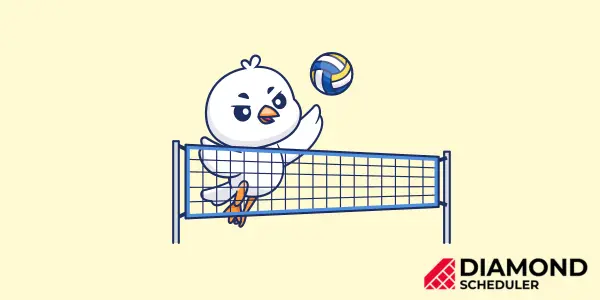
Mastering the Game: Exploring Essential Volleyball Equipment
Volleyball is an energetic and thrilling sport that requires only a few essential pieces of equipment to get started. The appropriate equipment, however, can significantly impact your performance and general pleasure of the game.
In this article, we'll look at important volleyball gear that all players—from rookies to seasoned veterans—should take into account. We'll cover everything, from the fundamentals, such as the volleyball itself, to specialty footwear and safety equipment.

The core gear for players
Volleyball
The volleyball itself is the most essential piece of equipment in the game. Volleyballs come in a variety of sizes, but a regulation-size ball is required for conventional play.
The approved size and weight for indoor volleyball are between 25.6 and 26.4 inches in circumference and 9.2 and 9.9 ounces, respectively. In contrast, beach volleyball balls are a little bit bigger and lighter to adapt to the various playing conditions on the sand.
You should take into account elements like price, brand, material, and structure while selecting a volleyball. Typically, synthetic leather is used to create high-quality volleyballs because it provides good grip and durability.
Popular companies like Mikasa, Molten, and Wilson are renowned for making excellent volleyballs that adhere to the criteria established by the sport's governing bodies.
Volleyball net and antennas
A net is used to separate the two teams and mark the borders of the court in official volleyball matches. For men's play, the net should be 39 inches wide and 7 feet, 11 5/8 inches tall; for women's play, it should be 7 feet, 4 1/8 inches tall.
Purchasing a sturdy volleyball net that can endure the demands of the game is crucial. Additionally, the net needs antennae poles, which are skinny fiberglass rods that protrude vertically from the top of the net.
The players and referees can use these antennas to assess if the ball has crossed the net inside the court's perimeter. They are essential to the game because they uphold fair play.
Volleyball apparel
Volleyball players must wear comfortable and appropriate clothing. While there isn't a set dress code for leisure play, uniforms are frequently required for competitive games. The following are some necessary volleyball-related outfits:
Jersey: For team identification during official competitions, players don numbered jerseys. Pick a jersey that fits comfortably and allows for movement.
Shorts: Volleyball shorts are made to be cozy and offer a full range of motion. In order to keep you dry during hard bouts, they are frequently manufactured with moisture-wicking materials.
Socks: It's recommended to invest in supportive, blister-free socks that wick away moisture.
Headbands: Some athletes choose headbands and wristbands to prevent sweat from getting into their eyes and hands while they play.
Compression apparel: Especially for lengthy competitions or competitive play, compression shorts, tights, or sleeves can aid in muscle support and recovery.
When selecting volleyball attire, keep in mind that comfort and range of motion are crucial. To stay dry and cool during matches indoors, use clothing made of fabrics that wick sweat from the body.
Essential volleyball equipment | SIKANA EnglishVolleyball shoes
Volleyball is a game that calls for a lot of lateral movement, quick direction changes, and jumping. You need the appropriate footwear in order to carry out these tasks efficiently.
Shoes made specifically for volleyball players offer the support, stability, and cushioning needed to meet the demands of the sport.
Some important characteristics of volleyball shoes are:
Traction: The non-marking rubber sole of volleyball shoes has a special tread pattern that offers good traction on grass and indoor courts without leaving scuff marks.
Cushioning: Gel or foam cushioning is frequently used in the midsole of these shoes to absorb shock and lower the chance of injuries, particularly during leaps and landings.
Ankle support: To help prevent ankle sprains, a common injury in the sport, many volleyball shoes feature a high-top design or added ankle support.
Lightweight: To allow for fast movements and hops, volleyball shoes are often made of lightweight materials.
Shoes made specifically for volleyball are available for both men and women from well-known shoe manufacturers including ASICS, Mizuno, and Adidas.
Digging into essential protective gear
In the team sport of volleyball, protective equipment is essential to maintain players' health and safety while they compete in this rapid and exciting activity.
Even though volleyball is often seen as a contact-free sport, injuries can nevertheless happen as a result of quick movements, forceful spikes, and dives. The required safety equipment is described here in more detail:
Volleyball knee pads
In volleyball, knee injuries are common because players frequently dive or slide across the court to rescue a ball. Wearing knee pads is advised to shield your knees from scrapes, bruises, and more serious wounds.
The knees that are cushioned and supported by knee pads, enable players to slide and dive without worrying about getting hurt.
Keep the following in mind when selecting knee pads for women's and men's volleyball
Size: Make sure the knee pads are the right size so they are secure throughout play. Your knees should be totally covered by them.
Padding: Look for knee protectors that have enough cushioning to absorb shock. Typically, cushioning is made of gel or foam.
Durability: Choose knee pads that are constructed of sturdy materials and that can resist the friction and impact of a game.
Breathability: To reduce excessive perspiration and discomfort choose knee pads that are made with breathable fabrics.
You can choose a pair of knee pads that matches your tastes and price range because they come in a variety of styles and pricing points.
Elbow pads
Players on the volleyball court, especially liberos, may find it beneficial to wear elbow guards or arm sleeves. When athletes dive and land on their elbows, these pads provide protection, reducing the possibility of more serious injuries and painful abrasions.
Floor contact protection: When trying to dig or save a ball, volleyball players frequently dive or slide on the ground to make plays. When athletes make contact with the hard gym floor, elbow pads cushion and protect the elbows to lower the chance of abrasions, bruises, or more severe injuries.
Confidence and aggressiveness: Players may be more inclined to dive or make aggressive moves if they are aware that they have additional protection, which can be vital in professional volleyball.
A player's confidence in their ability to dive for balls without fear of injury might be increased with elbow protection.
Versatility: Players of beach volleyball and indoor volleyball can both use elbow pads. Players frequently dive onto the sand when playing beach volleyball, which can potentially result in injuries and discomfort. In both indoor and outdoor situations, elbow protectors help reduce these problems. While elbow pads can be useful, it's vital to remember that they should be carefully chosen to provide a suitable fit, enough protection, and no restriction on a player's range of motion. As elbow pads are not a replacement for correct form and training, players should still use proper diving and sliding tactics to reduce the chance of injury.
Ankle braces
In volleyball, ankle braces are frequently used to support and stabilize the ankle joint. A lot of lateral movements, abrupt direction changes, and jumping are all part of volleyball play, which can impose stress on the ankles and raise the risk of injury.
Players who have previously had ankle injuries can benefit from additional support from ankle braces, which can help lower the likelihood of ankle sprains. Consider the following important factors when using ankle braces in volleyball:
Injury prevention: Ankle braces are frequently used as a preventative measure to lessen the possibility of ankle injuries, particularly sprains. They aid in limiting excessive side-to-side movement, which is typical in volleyball, and stabilize the ankle joint.
Rehabilitation: Ankle braces can be used by athletes who have previously injured their ankles during the rehabilitation process. As they return to the sport and gradually build up their ankle's strength and stability, these braces can offer extra support.
Balance with strength training: Although ankle braces can offer support, volleyball players must also do strength and balance drills to increase ankle stability and eventually lessen their reliance on braces.
Nets and court setup
Indoor nets
Volleyball is played throughout the year, which allows athletes to enjoy different volleyball seasons, in addition to experiencing different net heights and court dimensions.
Nets are an important part of the game of indoor volleyball. They are used to separate the two teams and to establish the playing area's borders. Here are some important facts concerning indoor volleyball nets:
Height: The regulation height of an official volleyball net for men's play is 7 feet 11 5/8 inches (2.43 meters), and 7 feet 4 1/8 inches (2.24 meters) for women's play. The net height for junior and youth divisions can be changed to fit the age category.
Width: A conventional indoor volleyball net is 32 feet (9.75 meters) wide for both men's and women's play. From each sideline, the net should extend 7 feet 4 1/8 inches (2.24 meters).
Material: Indoor volleyball nets are normally constructed of high-quality netting material, with square or rectangular apertures. The net's top is strengthened with a cable or rope, and the bottom may be weighted to keep it taut.
Beach nets
These nets are different from indoor volleyball nets in terms of size, setup, and materials because they are made expressly for usage outdoors in outdoor settings. The following are some essential qualities of beach volleyball nets:
Dimensions: Beach volleyball nets normally measure 28 feet (8.5 meters) wide for women's play and 32 feet (9.75 meters) wide for men's and coed play.
For official tournaments, the net is the same height for men's and women's games, measuring 7 feet 11 5/8 inches (2.43 meters). The height of the net is calculated from its center.
Material: Beach and sand volleyball nets are built of strong materials that can survive outside elements including the sun, sand, wind, and sporadic contact with water. They are often made of high-quality, climate-resistant materials like nylon or polyethylene.

Training aids and accessories
There are some tools and equipment made to assist volleyball players in honing their abilities, enhancing their performances, and developing an understanding of the game.
These tools are accessible to athletes of all skill levels, from novices to seasoned competitors, and they focus on different facets of the volleyball game itself. The following are some popular volleyball training tools:
Volleyball practice nets: These are specialty nets with targets and markings to help players practice hitting placement and precision. To imitate game scenarios, they can be adjusted to various heights and angles.
Spike trainer: Without a setter present, players can improve their timing and technique for spiking by using a spike trainer, a device that holds the volleyball in place. This is particularly helpful for budding hitters.
Passing and setting targets: To improve passing and setting accuracy, players can use these lightweight, portable targets to attach to a partner or a wall. They frequently have designated target zones for certain passes and sets.
Blocking aids: Blocking is an essential volleyball ability, and equipment like blocking pads and blocking dummies can be used to help players improve their timing, footwork, and blocking technique.
Serving machines: Players can practice their serve reception skills by using serving machines, which are engineered to deliver consistent, accurate serves at a range of speeds and angles.
Frequently asked questions
Volleyball is a thrilling sport and the appropriate equipment can significantly impact your performance and general pleasure of the game.
What equipment do I need when starting a volleyball game?
It is necessary to have a volleyball, a water bottle, kneepads, ankle supports, and volleyball shoes. When playing on hardwood, you should wear kneepads and shoes to prevent serious knee hits.
What actions are recommended before tryouts in volleyball?
Prepare to warm up after arriving early. There are various reasons why you should warm up before a tryout. The most crucial reason is that warming up increases your chances of performing at your best.
Warming up also gets your blood flowing and your muscles ready which minimizes your chances of getting hurt during the audition.
Recap
Although volleyball requires little equipment, the appropriate equipment can significantly improve your performance and safety.
Buying important volleyball gear such as the correct ball, net, shoes, and protective clothing is essential whether you're playing for enjoyment or competing at a high level.
You may get the most out of the game and lower your chance of injury by choosing high-quality equipment that fits your playing style and needs. So, with this information, players should be ready to gear up, hit the court, and spike their way to victory!
As a current or future league owner looking to learn more about volleyball equipment and best practices, you're probably also wondering how can you possibly create the most efficient schedule for your league while juggling all the other responsibilities.
With Diamond Scheduler, scheduling is a breeze! With seamless tournament creation and streamlined scoring input options, managing the season is easier than ever before.
Jeff Tipper is an avid sports fan who has a strong passion for basketball. A graduate of the University of New Mexico with a Bachelor's Degree in Operations Management, Jeff has experience in operations and claim processing and spends his free time writing articles and blogs focused on sports and various business topics.
About Diamond Scheduler
Diamond Scheduler makes planning your league’s complex season easier than ever. Create your first schedule in minutes for free. It's fast, fun, and simple.


